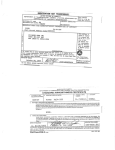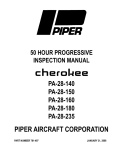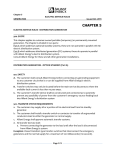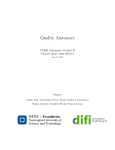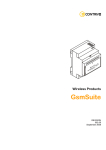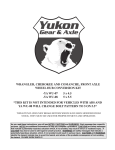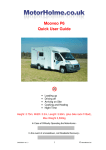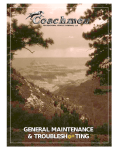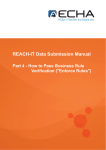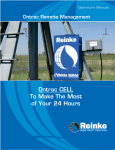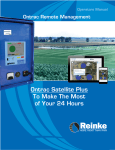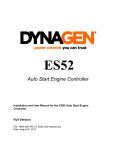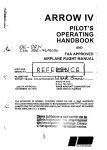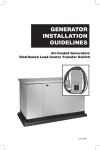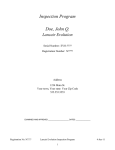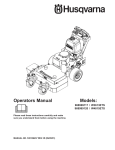Download 230-203 - INSPECTION REPORT - PA-24 / 250
Transcript
PIPER AIRCRAFT CORPORATION INSPECTION REPORT This form meets requirements of FAR Part 43 • Inspections must be performed by persons authorized by the FAA. WARNING: USE EXTREME CAUTION WHEN ROTATING PROPELLER BY HAND; PROPELLER MAY KICK BACK. PRIOR TO ROTATING PROPELLER ENSURE BOTH MAGNETO SWITCHES ARE OFF (GROUNDED). IF MAGNETOS ARE NOT GROUNDED, TURNING PROPELLER MAY START ENGINE. 1. 2. 3. 4. 5. 6. Inspect spinner and back plate for cracks ................................ O Inspect blades for nicks and cracks.......................................... O Inspect for grease and oil leaks................................................ O Lubricate per lubrication chart in Section II .............................. Inspect spinner mounting brackets for cracks .......................... Inspect propeller mounting bolts for condition and security. If safety is broken, re-torque and safety ................................... 7. Inspect pitch actuating arms and bolts ..................................... 8. Inspect hub parts for cracks and corrosion .............................. 9. Rotate blades and check for tightness in hub pilot tube ........... O O O O O O O O O B. ENGINE GROUP WARNING: GROUND MAGNETO PRIMARY CIRCUIT BEFORE WORKING ON ENGINE. NOTE: Read Notes 5 and 13 prior to completing this inspection group. 1. Remove the engine cowl .......................................................... 2. Clean and check cowling for cracks, distortion and loose or missing fasteners ..................................................................... 3. Drain oil sump. (See Note 7.) ................................................... 4. Clean suction oil strainer at oil change (inspect strainer for foreign particles)....................................................................... 5. Clean pressure oil strainer or change full flow (cartridge type) oil filter element. (Inspect strainer or element for foreign particles.) .................... 6. Inspect oil temperature sender unit for leaks and security ....... 7. Inspect oil lines and fittings for leaks, security, chafing, dents and cracks. (See Special Inspections.)........................................................ 8. Clean and inspect oil radiator cooling fins................................ 9. Inspect rocker box covers for evidence of oil leaks. If found, replace gasket. Torque cover screws 50 inch-pounds. (See Note 8.) ................ 10. Inspect wiring to engine and accessories. Replace damaged wires and clamps. Inspect terminals for security and cleanliness.......................... 11. Inspect spark plug cable leads and ceramics for corrosion and deposits ........................................................ 12. Inspect cylinder compression. (See latest revision of AC 43.13-1.).......................................... 13. Inspect cylinders for cracked or broken fins ............................. 14. Fill engine with oil per lubrication chart and Table II-VI ............ CAUTION: O O O O O O O O O O O O 17. Inspect ignition harnesses and insulators for high tension leakage and continuity ........................................ 18. Inspect magnetos. (See Notes 6 and 9.) .................................. 19. Remove air cleaner screen and clean. (Refer to Section II.) .... 20. Drain carburetor and remove and clean carburetor inlet screen or remove and clean fuel injector inlet screen. (Clean injector nozzles as required.) (Clean with acetone only.) ........................................................ 21. Inspect condition of carburetor heat or alternate air door and box ........................................................ 22. Inspect intake seals for leaks and clamps for tightness ........... 23. Inspect condition of flexible fuel lines ....................................... 24. Inspect fuel system for leaks. (See Note 19.) ........................... 25. Clean screens in plunger type electric fuel pump(s) per paragraph 8-23.............................................. 26. Inspect engine-driven and electric fuel pumps for condition and operation. (See Note 6.)..................................... 27. Inspect vacuum pumps and lines. (See Notes 15 and 25.) ...... 28. Inspect throttle, carburetor heat or alternate air, mixture and propeller governor controls for travel and operating condition ................................................................... 29. Inspect exhaust stacks, connections and gaskets per Exhaust System Inspection under Special Inspections, Procedures. Replace gaskets as required. (See Note 26.)........................... 30. Inspect muffler, heat exchanger and baffles per Exhaust System Inspection under Special Inspections, Procedures. ............................................ 31. Inspect breather tube for obstructions and security ................. 32. Inspect crankcase for cracks, leaks and security of seam bolts .............................................. 33. Inspect engine mounts for cracks and loose mounting ............ 34. Inspect rubber engine mount bushings for deterioration ......... 35. Inspect all engine baffles for cracks ......................................... 36. Inspect firewall for cracks ......................................................... 37. Inspect condition of firewall seals ............................................. 38. Inspect condition and tension of generator or alternator drive belt................................................................... 39. Inspect condition of generator or alternator and starter ........... 40. Lubricate all controls per lubrication chart in Section II............ 41. Reinstall engine cowling; except for PA-24-260 Turbo, proceed to Turbocharger Group ................... O O O O O O O O O O O O O O O O O O O O O O O O O O O O O O O O O O O O O O O O O O O O O O C. TURBOCHARGER GROUP (PA-24-260 TURBO ONLY) O O O O O O O DO NOT CONTAMINATE VACUUM PUMP WITH CLEANING FLUID. 15. Clean engine ............................................................................ 16. Inspect condition of spark plugs. (Clean and adjust gap as required, 0.015 to 0.018 or 0.018 to 0.022 per latest revision of Lycoming Service Instruction No. 1042.) .................................. DESCRIPTION 100 A. PROPELLER GROUP Perform all inspections or operations at each of the inspection intervals as indicated by a circle (O) 50 100 DESCRIPTION 50 Circle Type of Inspection (See Notes 1, 2, 3 and 4) 50 100 Annual Registration No.: Inspector Model No.: PA - 24 / Serial No.: PA-24-250 / -260 / -400 Inspector Model Name: COMANCHE O O 1. Inspect all air inlet ducting and compressor discharge ducting for worn spots, loose clamps or leaks ..................................... 2. Inspect engine air inlet assembly for cracks, loose clamps and screws ......................................................... 3. Inspect wastegate housing, exhaust ducting, and exhaust stacks for signs of leaks or cracks............................................ 4. Carefully inspect all turbo support brackets, struts, etc., for breakage, sagging or wear.................................................. 5. Inspect all oil lines, fuel lines, and fittings for wear, leakage, heat damage or fatigue (See Special Inspections) .... 6. Actuate wastegate control; check spring pre-load and examine control for any pending sign of breakage................... 7. Inspect V-Band Coupling per paragraph 7C-24........................ 8. Remove inlet hose to compressor and visually inspect compressor wheel .................................................................... O NOTE: If fouling of spark plugs has been apparent, rotate bottom plugs to upper plugs. Owner: PA-24/24-250/260/400 COMANCHE (PART NUMBER 230-203) —1— APRIL 1, 2009 C. TURBOCHARGER GROUP (CONT.) 9. Inspect the compressor wheel for nicks, cracks or broken blades ........................................................................... 10. Inspect for excess bearing drag or wheel rubbing against housing................................................. 11. Inspect induction and exhaust components for worn or damaged areas, loose clamps, cracks and leaks. ................... 12. Inspect turbine wheel for broken blades or signs of rubbing .... 13. Inspect turbine heat blanket for condition and security ............ 14. Inspect rigging of exhaust wastegates ..................................... 15. Inspect rigging of alternate air control ...................................... 16. Reinstall engine cowl................................................................ 17. Run up engine, check instruments for smooth, steady response ....................................................................... O PA-24/24-250/260/400 COMANCHE (PART NUMBER 230-203) Inspector 100 50 DESCRIPTION E. FUSELAGE AND EMPENNAGE GROUP O O O O O O O O O D. CABIN AND COCKPIT GROUP 1. Inspect cabin entrance door, baggage compartment door and windows for damage, operation and security .................... 2. Inspect upholstery for tears ...................................................... 3. Inspect seats and attaching brackets and hardware for condition, security and operation.............................................. 4. Inspect seat belts and shoulder harnesses per paragraph 13-1A ...................................................................... 5. Inspect trim operation............................................................... 6. Inspect rudder pedals, brake handle and/or toe brake pedals, and cylinders for condition, security, operation and leaks. (See Note 10.) .......................................................................... 7. Inspect parking brake ............................................................... 8. Inspect control wheels, column, pulleys and cables................. 9. Inspect landing, navigation, cabin and instrument lights .......... 10. Inspect instruments, lines and attachments ............................. 11. Inspect condition of vacuum operated instruments and operation of electric turn and bank. (Overhaul or replace as required.) ........................................... 12. If installed, replace vacuum regulator filter element ................. 13. Inspect static system, altimeter and transponder for installation/certification per latest revision of AC-43. 13-1 and current test/inspection per FAR’s 91.411 and 91.413, respectively .............................. 14. Inspect and test ELT per FAR 91.207. (See paragraph 12-3.).. 15. Inspect oxygen outlets for defects and corrosion ..................... 16. Inspect oxygen system operation and components ................. 17. Inspect fuel selector valve for ease of rotation. If difficult to rotate, see paragraphs 8-14, 8-15, or 8-16, as appropriate .......................................................................... 18. In PA-24-400s, inspect the fuel selector valve for internal leaks per paragraph 8-16 ....................................... O 19. If installed, inspect disposable-type (non-gauged) fire extinguisher minimum weight as specified on nameplate .. Perform all inspections or operations at each of the inspection intervals as indicated by a circle (O) Inspector 100 DESCRIPTION 50 Circle Type of Inspection (See Notes 1, 2, 3 and 4) 50 100 Annual O O O O O O O O O O O O O O O O O O O 1. Remove inspection panels and plates. (See Special Inspections.)........................................................ 2. Inspect fluid in brake reservoir. (Fill as required.)..................... O 3. Inspect battery, box and cables. Clean and flush box as required and fill battery per Section IX ................................ 4. Inspect electronic installations. (See Note 24.) ........................ 5. Inspect skins, bulkheads, frames, and stringers for damage, irregularities,or structural defects (i.e. - skin cracks, distortion, dents, corrosion, and loose or missing rivets). ......................... 6. Inspect loop and loop mount, antenna mount and electric wiring ........................................................................... 7. Inspect ELT battery for condition/date per FAR 91.207............ 8. Inspect ELT installation and antenna for condition and security. Replace antenna if bent or damaged ......................... 9. Remove, drain, and clean fuel filter bowl and screen............... 10. Inspect fuel lines, valves and gauges for damage and operation .................................................................................. 11. Inspect security of all lines ....................................................... 12. Inspect stabilator and stabilator trim tabs for security of mounting,free play of components and ease of operation. (See Sections IV and V.)........................................................... 13. Inspect stabilator bearings, bungee, and stabilator trim horns control rod and trim mechanism for security of installation, damage and operation ......................... 14. Inspect stabilator tip balance weight arm for cracks................. 15. Inspect vertical fin front spar to fuselage attachment, per latest revisionof FAA AD No. 75-12-06 ............................... 16. Inspect vertical fin for surface damage or irregularities (i.e. - skin cracks, distortion,dents, corrosion, and excessive paint build up); structural defects (i.e. - loose or missing rivets); misrigging or structural imbalance; hinge damage, excessive wear, freedom of movement and proper lubrication; and attachment points for missing or worn hardware...................... 17. Inspect rudder for surface damage or irregularities (i.e. - skin cracks, distortion,dents, corrosion, and excessive paint build up); structural defects (i.e. - loose or missing rivets); misrigging or structural imbalance; hinge damage, excessive wear, freedom of movement and proper lubrication; and attachment points for missing or worn hardware...................... 18. Inspect stabilator for surface damage or irregularities (i.e. - skin cracks, distortion,dents, corrosion, and excessive paint build up); structural defects (i.e. - loose or missing rivets); misrigging or structural imbalance; hinge damage, excessive wear, freedom of movement and proper lubrication; and attachment points for missing or worn hardware............... 19. Inspect rudder and rudder tab hinges, horns and attachmentsfor security, damage and operation....................... 20. Inspect rudder trim mechanism operation ................................ 21. Inspect rudder, stabilator, and stabilator trim cables; and cable terminals, turnbuckles, guides, fittings, and pulleys for safety, condition, and operation. (See Note 14.)....................... 22. Inspect rudder, stabilator, and stabilator trim cable tension per Table V-I. Use a tensiometer. .............................................. 23. Inspect rotating beacon for wear, etc ....................................... 24. Lubricate per lubrication chart in Section II .............................. 25. Inspect security and condition of Autopilot bridle cables and clamps ............................................................................... 26. Reinstall inspection panels and plates ..................................... —2— O O O O O O O O O O O O O O O O O O O O O O O O O O APRIL 1, 2009 F. WING GROUP 1. Remove inspection plates and fairings..................................... 2. Inspect wing surfaces for damage, loose rivets, and condition of wing tips ......................................................... 3. Inspect condition of walkway .................................................... 4. Inspect wing attachment bolts and brackets............................. 5. Inspect aileron for surface damage or irregularities (i.e. - skin cracks, distortion,dents, corrosion, and excessive paint build up); structural defects (i.e. - loose oror missing rivets); misrigging or structural imbalance; hinge damage, excessive wear, freedom of movement and proper lubrication; and attachment points for missing or worn hardware. (See Notes 23 and 24.) ............ 6. Inspect aileron cable tension per Table V-I. Use a tensiometer. ................................................................... 7. Inspect aileron attachments and hinges for damage, looseness and operation .......................................................... 8. Inspect aileron balance weights and arms for security and condition ................................................................................... 9. Inspect aileron cables; and cable terminals, turnbuckles, guides, fittings, pulleys, and bellcranks for safety, condition, and operation. (See Note 14)................................... 10. Inspect flaps for surface damage or irregularities (i.e. - skin cracks, distortion,dents, corrosion, and excessive paint build up); structural defects (i.e. - loose or or missing rivets); misrigging or structural imbalance; hinge damage, excessive wear, freedom of movement and proper lubrication; and attachment points for missing or worn hardware. .................................................. 11. Inspect flap attachments and hinges, or tracks and rollers for damage, looseness and operation. Clean tracks and rollers.... O 12. Inspect flap cables, pulleys, step lock, bellcranks and rods for safety, condition, and operation. (See Note 14.)....................... 13. Lubricate per lubrication chart in Section II .............................. O 14. Inspect fuel cells and lines for leaks and water. Visually inspect the lower wing surfaces for tell-tale fuel stains. (See Note 22.)........................ 15. Inspect thermos type fuel filler cap for condition and security. Inspect rubber seals for brittleness and deterioration .............. 16. Fuel fillers marked for capacity................................................. 17. Fuel fillers marked for minimum octane rating.......................... 18. Inspect switches to indicators registering fuel tank quantity..... 19. Inspect fuel cell vents ............................................................... 20. Reinstall inspection plates and fairings .................................... O O O O O PA-24/24-250/260/400 COMANCHE (PART NUMBER 230-203) 20. Inspect emergency operation of gear. (See paragraph 6-107.) ............................................................. 21. Inspect landing gear motor, transmission and attachments ..... 22. Inspect Landing Gear Transmission Retract Spring for condition, security and operation. (See Figure 6-13, Item 14 or 15.) ............................................. 23. Inspect anti-retraction system .................................................. 24. Inspect position indicating switches and electrical leads for security ..................................................................................... 25. Inspect rubber assist bungee cords and check bungee arms for wear, cracks and/or deformation. ........................................ 26. Lubricate per lubrication chart in Section II .............................. 27. Remove airplane from jacks ..................................................... Inspector 100 50 DESCRIPTION O O O O O O O O H. SPECIAL INSPECTIONS O See Special Inspections, Requirements, below. O I. OPERATIONAL INSPECTION O 1. 2. 3. 4. 5. 6. 7. 8. 9. 10. 11. 12. 13. 14. 15. 16. 17. 18. 19. 20. Check fuel pump and fuel tank selector operation ................... Check indication of fuel quantity and pressure / flow gauges .. Check oil pressure and temperature indications ...................... Check generator or alternator output ....................................... Check manifold pressure indications........................................ Check operation of carburetor heat or alternate air.................. Check operation of brakes and parking brake.......................... Check operation of vacuum gauge........................................... Check gyros for noise and roughness ...................................... Check cabin heat operation...................................................... Check magneto switch operation ............................................. Check magneto RPM variation................................................. Check throttle and mixture operation ....................................... Check engine idle..................................................................... Check propeller smoothness.................................................... Check propeller governor action .............................................. Check electronic equipment operation ..................................... Check operation of controls...................................................... Check operation of flaps........................................................... Check operation of Autopilot, including automatic pitch trim, and Manual Electric Trim. (See Note 12.) ................................. O O O O O O O O O O O O G. LANDING GEAR GROUP 1. Inspect oleo struts for proper extension and evidence of fluid leakage.(See Landing Gear, Section II.)........................... O 2. Inspect nose gear steering control ........................................... 3. Inspect wheels for alignment .................................................... 4. Put airplane on jacks ................................................................ 5. Inspect tires for cuts, uneven or excessive wear & slippage .... 6. Remove wheels, clean, inspect and repack bearings .............. 7. Inspect wheels for cracks, corrosion and broken bolts ............. 8. Check tire pressure. (Refer to Section II.) ................................ O 9. Inspect brake linings and discs for condition and wear. (See Note 21.) .......................................................................... O 10. Inspect brake backing plates for cracks.................................... 11. Inspect hydraulic lines, electrical leads, and attaching parts for conditionand security (i.e. - routing, chafing, damage, wear, etc).................................................................................. 12. Inspect condition of shimmy dampener.................................... 13. Inspect gear forks for damage.................................................. 14. Inspect oleo struts for fluid leaks and scoring .......................... 15. Inspect gears struts, attachments, torque links, retraction links and bolts for operation. (See Note 11.) ............................ 16. Inspect gear doors and attachments. (See Notes 16, 17 and 18). ...................................................... 17. Inspect warning horn and light for operation ............................ 18. Retract gear - Check operation ................................................ 19. Retract gear - Check doors for clearance and operation.......... Perform all inspections or operations at each of the inspection intervals as indicated by a circle (O) Inspector 100 DESCRIPTION 50 Circle Type of Inspection (See Notes 1, 2, 3 and 4) 50 100 Annual O O O O O O O O O O O O O O O O O O O O O O O O O O O O O O O O O O O O O O O O O O O O O O O O O O O O O O O O J. GENERAL 1. Aircraft conforms to FAA Specifications ................................... 2. Latest revision of applicable FAA Airworthiness Directives complied with .......................................................... 3. Current and correct Airplane Flight Manual (AFM) is in the airplane ....................................................................... 4. Check airplane for required placards as identified in the Limitations section of the AFM ................................................. 5. Appropriate entries made in the Aircraft and Engine Log books..................................................................... 6. Registration Certificate is in the aircraft and properly displayed .................................................................... 7. Aircraft Equipment List, Weight and Balance and FAA Form(s) 337 (if applicable) are in the aircraft and in proper order.......................................................................... 8. Operational inspection and run-up completed.......................... 9. Aircraft cleaned and lubricated after wash (as required).......... O O O O O O O O O O O O O O O O O O O O —3— APRIL 1, 2009 K. NOTES 1. Refer to Piper's Customer Service Information File P/N 1753-755 for latest revision dates to Piper Inspection Reports/Manuals and the Comanche Service Manual, P/N 753-516. References to section, paragraph, figure, or table are to the appropriate section, paragraph, figure, or table in the service manual. WARNING: INSTRUCTIONS FOR CONTINUED AIRWORTHINESS (ICA) FOR ALL NON-PIPER APPROVED STC INSTALLATIONS ARE NOT INCLUDED IN THIS MANUAL. WHEN A NON-PIPER APPROVED STC INSTALLATION IS INCORPORATED ON THE AIRPLANE, THOSE PORTIONS OF THE AIRPLANE AFFECTED BY THE INSTALLATION MUST BE INSPECTED IN ACCORDANCE WITH THE ICA PUBLISHED BY THE OWNER OF THE STC. SINCE NON-PIPER APPROVED STC INSTALLATIONS MAY CHANGE SYSTEMS INTERFACE, OPERATING CHARACTERISTICS AND COMPONENT LOADS OR STRESSES ON ADJACENT STRUCTURES, THE PIPER PROVIDED ICA MAY NOT BE VALID FOR AIRPLANES SO MODIFIED. 2. Inspections or operations are to be performed as indicated by a “O” at the 50 or 100 hour inspection interval. Inspections or operations (i.e. – component overhauls/replacements, etc.) required outside the 50/100 hour cycle are listed as special inspections in paragraph 3-8. Inspections must be accomplished by persons authorized by the FAA. (a) The 50 hour inspection accomplishes preventive maintenance, lubrication and servicing as well as inspecting of critical components. (b) The 100 hour inspection is a complete inspection of the airplane, identical to an annual inspection. NOTE: A log book entry should be made upon completion of any inspections. 3. Piper Service Bulletins are of special importance and Piper considers compliance mandatory. In all cases, see Service Bulletin/Service Letter Index P/N 762-332 to verify latest revision. See also Table III-II. 4. Piper Service Letters are product improvements and service hints pertaining to servicing the airplane and should be given careful attention. 5. Inspections given for power plant are based on the engine manufacturer’s operator’s manual (Lycoming P/N 60297-19) for this airplane. Any changes issued to the engine manufacturer’s operator’s manual supersede or supplement the instructions outlined in this report. Should fuel other than the specified octane rating for the power plant be used, refer to the latest revision of Lycoming Service Letter No. L185 for additional information and recommended service procedures. 6. Replace or overhaul as required or at engine overhaul. 7. Refer to latest revisions of Lycoming Service Bulletin No. 480 and Lycoming Service Instruction No. 1014. Lycoming recommends the following oil change intervals: (a) For engines equipped with full-flow oil filters, change the oil and filter each 50 hours of engine operation or every four months, whichever comes first; (b) For engines relying upon pressure screen filtration alone, change the oil and clean the pressure and suction screens each 25 hours of engine operation or every four months, whichever comes first. 8. Check cylinders for evidence of excessive heat indicated by burned paint on the cylinders. This condition is indicative of internal damage to the cylinder and, if found, its cause must be determined and corrected before the aircraft is returned to service. Heavy discoloration and appearance of seepage at the cylinder head and barrel attachment area is usually due to emission of thread lubricant used during assembly of the barrel at the factory, or by slight gas leakage which stops after the cylinder has been in service for awhile. This condition is neither harmful nor detrimental to engine performance and operation. If it can be proven that leakage exceeds these conditions, the cylinder should be replaced. 9. Inspect and clean magneto(s) per the procedures in the Periodic Maintenance section of the applicable Service Support Manual, available from Teledyne Continental Motors, Inc., PH: (800) 718-3411, or http://www.tcmlink.com/. 10. In PA-24 / PA-24-250 S/N’s 24-1 thru 24-2298, less 24-2175: perform Hand Brake / Master Cylinder Control Cable Inspection per paragraph 6-88a. 11. Refer to Section VI for proper inspection and wear limits. 12. Refer to Flight Manual supplement for preflight and flight check, for intended function in all modes. 13. In PA-24-260 Turbo airplanes equipped with Bendix S-1200 series magnetos, S/N’s lower than “86100025” and data plates not stamped with a “T,” that have brown magneto distributor blocks P/N 10-391586 with molded batch codes 0000 thru 8601: inspect in accordance with Bendix Service Bulletin No. 629 per Piper Vendor Service Publication No. 69. 14. Examine cables for broken strands by wiping the cable with a cloth along the entire length of the cable. Visually inspect the cable thoroughly for damage not detected by the cloth. Replace damaged or frayed cables. (a) See Control Cable Inspection, paragraph 5-4A, or the latest edition of FAA Advisory Circular 43.13-1. (b) At fifteen (15) years time-in-service, begin Cable Fittings 100 Hour Special Inspection, paragraph 5-4A. 15. For airplanes equipped with Parker Hannifin / Airborne vacuum pump(s), verify compliance with Parker Hannifen / Airborne Service Letter No. 72. 16. In PA-24 and PA-24-250 Serial Nos. 24-1 thru 24-2620, 24-2632 thru 24-2634, 24-2642, 24-2646, 24-2648 thru 24-2652, and 24-2683 thru 24-2684 for those airplanes which have not installed a stainless steel door hinge P/N 21065-12, on the left main landing gear, visually inspect hinges for cracks. 17. In PA-24 and PA-24-250 S/N’s 24-1 thru 24-2438, 24-2640 thru 24-2666, 24-2668 thru 24-2674, 24-2676, and 24-2678 thru 24-2679 for airplanes which have not installed a stainless steel door hinge, P/N 21065-12, on the right main gear: visually inspect hinges for cracks. 18. In PA-24, PA-24-250, and PA-24-260 S/N’s 24-1 thru 24-4803, less 24-4783: inspect nose gear door hinge bushings, P/N 80012-97, for evidence of excessive wear. Replace as required. 19. In PA-24-260 S/N’s 24-4783, 24-4804 thru 24-5034, and PA-24-400 S/N’s 26-2 thru 26-148 only, for airplanes equipped with an AN-type enginedriven fuel pump, Lear/Romec P/N RG17980, without a “/M” suffix following the Lear/Romec part number: visually inspect the split lines between the pump housing, relief valve housing, and relief valve cover for evidence of fuel leakage or noticeable gasket extrusion adjacent to the pump inlet or outlet ports. If noticeable gasket extrusion or fuel leakage is evident, see latest revisions of Crane/Lear Romec Service Bulletin No. 101SB020, Rev. 3, per Lycoming Service Bulletin No. 529B and Piper Service Bulletin No. 1035A. 20. For airplanes which have not installed Piper Kit No. 763-893, inspect aileron nose rib/bulkheads per Paragraph 4-7a. 21. In PA-24-400s equipped with Cleveland Main Wheel Assembly Model No. 40-90, at each tire change, or annually, whichever comes first, inspect the brake disc per Cleveland Service Bulletin No. 7071 (Piper Vendor Service Publication No. 134.) PA-24/24-250/260/400 COMANCHE (PART NUMBER 230-203) —4— APRIL 1, 2009 K. NOTES (CONT.) 22. In PA-24 and PA-24-250 S/N’s 24-2882 thru 24-3687 and PA-24-400 S/N’s 26-1 thru 26-69, 26-71 thru 26-79, 26-81 thru 26-96, 26-98, 26-99, 26-101 thru 26-103, 26-106, 26-108, 26-109, 26-112 thru 26-114, 26-116, 26-119 thru 26-121, 26-123 thru 26-125, and 26-147; if fuel stains are observed on the lower surfaces of a wing, inspect the fuel lines and fittings for any indication of leaks. If no leakage is attributable to the fuel lines and fittings then carefully inspect the upper panels of the fuel cells for evidence of seepage. If such evidence is found, replace the fuel cells. 23. For airplanes which have accumulated 1000 hours time-in-service or more and have not installed Piper Kit No. 760-914, inspect aileron spar per Paragraph 4-27a. 24. In PA-24-260 S/N’s 24-4567 and up, for airplaces equipped with Piper AutoControl III, AltiMatic III, AltiMatic IIIB or AltiMatic IIIB-1 Automated Flight Control Systems, perform the 100 Hour AutoControl III / AltiMatic III Autopilot Inspection in paragraph 12-7a. 25. In airplanes equipped with Aero Accessories, Inc. service replacement dry air pumps, which have accumulated 500 hours time-in-service or more, inspect vacuum pump vane wear per Paragraph 11-16a. 26. In PA-24-250 S/N’s 24-103 thru 24-1629, for airplanes which have not installed the improved right exhaust stack assembly P/N 24543-000, or have not modified the original equipment right exhaust stack assembly P/N 21664-003 with Piper Kit No. 754-396: each 50 hours time-in-service inspect the right exhaust stack assembly for any indication of cracks or deterioration. Thoroughly examine the area where the rear cylinder exhaust stack is welded to the right exhaust stack assembly. NOTE: Installation of P/N 24543-000 or Kit No. 754-396 relieves this inspection requirement. Signature of Mechanic or Inspector: PA-24/24-250/260/400 COMANCHE (PART NUMBER 230-203) Certificate No.: Date: —5— Total Time on Airplane: APRIL 1, 2009





